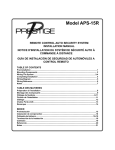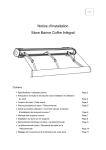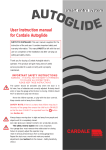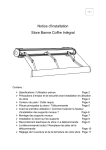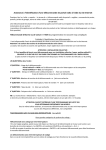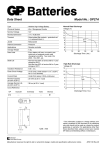Download Audiovox MA200C User's Manual
Transcript
MODEL MA200C REMOTE CONTROL MOTORCYCLE ALARM SYSTEM INSTALLATION GUIDE AND OWNERS MANUAL 1 Congratulations on the purchase of your new Audiovox Alarm System. Taking a few minutes to read this installation and owners guide will provide you with the detailed information concerning all the features of your new alarm system. MOUNTING THE SIREN/CONTROL MODULE 1. Choose a location that is away from hot and moving parts considering the Red wire length must be connected to the to the positive terminal of the battery. Prevent access to the siren as much as possible, by mounting in a hidden location. Typical locations are underneath the gas tank, seat or exterior body panels. Avoid areas which are subjected to water, engine heat or grease. 2. The internal tilt sensor will be most sensitive when the siren is oriented so that it is pointed toward the front or rear of the motorcycle. 3. Once you have selected a location, inspect the area to ensure that drilling the two required holes to mount the bracket will not penetrate wiring or fluid lines. Drill two 1/8" holes into the mounting surface on the motor cycle. Attach the bracket using the two screws provided. Mount the siren to the bracket using the two screws provided. Point the siren horn (front) downward or forward for the greatest volume in the event of an alarm. use an alternate +12 volt constant source such as the fuse panel or the ignition switch. Be sure to wire the 1 Amp fuse (included) as close to the battery connection as possible. WIRING THE SIREN (Refer to Figure 1 Overall Wiring Diagram) RED: Using the attached wire lug, connect the Red wire of the siren to the positive terminal of the battery. If you are familiar with your motorcycle's wiring, you may 2 BLACK (LONG): Using the attached wire lug, connect the Black (long) wire of the siren to the negative terminal of the battery or a good ground source. ORANGE: This wire is used to connect the alarm system to the motorcycle's ignition system Refer to Figure 2. This wire must be connected for the emergency override to function properly in case the transmitter is lost or stolen. When connected to the ignition switch, the wire is connected as is. The wire contains a series resistor. The resistor will get hot of an attempt is made to steal the motorcycle, so make sure it is not located near lowtemperature material. BLACK (SHORT): Stretch the short Black antenna wire as long as possible, avoiding metal contact if possible. This is the antenna wire for the alarm system; route it as high as possible! BROWN/BLACK: This wire is used when an additional horn is connected to the alarm system. To connect an additional horn, a relay is required (included in the kit). The relay may be used as a horn, park light or starter kill. The relay, whenever possible, should be protected from water, engine heat or grease. NOTE: Additional relays are available as part #AS-9256. Refer to Figure 4 and the accompanying instructions for connecting the horn relay feature. ORANGE FROM ALARM RESISTOR TO MOTORCYCLE IGNITION CIRCUIT FIGURE 2 This wire can also be connected to disable the starter or ignition. To disable a circuit on the motorcycle, a relay is required (included in the kit). The relay may be used as a horn, park light or starter kill. The relay, whenever possible, should be protected from water, engine heat or grease. NOTE: Additional relays are available as part #AS-9256. Additionally, the wire must be cut to remove the series resistor. The wire will then be connected to the optional relay. Refer to Figure 5. WHITE: This wire is used to connect the alarm system to the motorcycle's turn signal/running lights. This feature requires a relay (included in the kit). The relay may be used as a horn, park light or starter kill. The relay, whenever possible, should be protected from water, engine heat or grease. The relay should be mounted as near to the lights as possible. NOTE: Additional relays are available as part #AS-9256. Refer to Figure 6 for relay connections. MOUNTING A RELAY To mount a relay: 1. Screw the relay to the mounting surface, using a sheet metal screw through the hole in the relay mounting tab. 2. Secure the relay to an existing wire harness or other component using cable ties. Refer to Figure 3. 3 CONNECTING THE RELAY (HORN FEATURE) IMPORTANT! The relay has been shipped with the BLACK wire loaded into terminal 87a of the Relay Socket. The wire must be removed from this location and placed into the outer terminal of the Relay Harness 87. 1. Connect the ORANGE wire from the relay harness to the BROWN/BLACK wire from the main harness. Be sure to insulate this splice with electrical tape. Refer to Figure 4. 2. Gain access to the wires coming from the back of the horn. Beep the horn and locate the wire that changes polarity when the horn beeps. If the voltage goes low when beeping, then the horn is switched by a ground signal. If the voltage goes high when beeping, then the horn is switched by +12 volts. Connect the BLACK wire from the relay socket to this wire, and insulate the connection with electrical tape. Connect the WHITE/BLACK wire to ground or +12V as required by the horn. SHEET METAL RELAY RELAY WIRE TIE TO EXISTING FIGURE 3 To + or - as required by Horn Fuse if positive To Horn White/Black Black 30 85 86 To fused 12V constant source 87a 87 FIGURE 4 4 To Brown/Black wire of siren Orange module 3. Locate the wire coming from the starter switch that measures + 12 volts on the logic probe when the starter motor is cranking, and measures 0 volts when the key is switched to the "OFF" position. Cut this wire and try to start the vehicle to verify that the starter motor will not engage. You may also interrupt the ignition circuit of the motorcycle if an electric start wire is not available. Connect the WHITE/BLACK stripe wire from the relay harness to one side of the cut wire, and connect the BLACK wire to the other side of the cut wire. CAUTION: Be sure these wires are securely connected, and properly insulated. If this connection separates, the motorcycle will not start or run, even when using the ignition key. CONNECTING THE RELAY (STARTER/IGNITION) IMPORTANT ! When using the relay to disable the starter, leave the BLACK wire in terminal 87a of the relay connector in the location shown in the Figure 5. 1. Connect the ORANGE wire from the relay harness to the ORANGE wire from the siren harness. Be sure to insulate this splice with electrical tape. Refer to Figure 5. Be certain to remove the series resistor before connecting the relay. 2. Gain access to the wires coming from the ignition switch. Connect the RED wire from the relay harness to the wire from the ignition switch that measures + 12 volts when the key is switched to the "ON and START" positions, and measures 0 volts when the key is switched to the "OFF" position. Be sure to insulate this connection with electrical tape. To starter or ignition wire from key Cut To Start solenoid or ignition X White/Black Black 30 85 86 To +12V in run and crank 87a 87 FIGURE 5 5 Orange To Orange on MA200 To Bike Harness To Head Lamp Black White/Black 30 85 86 To fused 12V constant source 87a Orange To White wire of siren module 87 FIGURE 6 connection with electrical tape. Connect the WHITE/ BLACK wire to the other side of the headlight wire. 3. Connect both the RED wire from the relay socket and the WHITE/BLACK stripe wire from the relay socket to a + 12 volt battery fused wire (minimum 15 Amp fuse) in the motorcycle. These wires can be connected to the positive battery terminal, however when connecting them to the positive battery terminal, you must add an in line fuse of at least 15 Amps. Connect one side of the fuse to the positive battery terminal, and the other side of the fuse to the RED and WHITE/BLACK stripe wires from the relay connector. PROGRAMMING THE KEYCHAIN TRANSMITTERS: To Program the Transmitters: 1. Disarm the system by the manual override method or by a pre-programmed transmitter CONNECTING THE RELAY (HEAD LAMP FLASH FEATURE) IMPORTANT! When using the relay to flash the vehicle’s parking lights, unload the BLACK wire from terminal 87A of the relay harness and load it into terminal 87. Refer to Figure 6. 1. Connect the ORANGE wire from the relay harness to the WHITE wire from the main harness. Be sure to insulate this splice with electrical tape. Refer to Figure 6. 2. Gain access to the wires coming from the back of the head lamp socket. Switch the head lamp on, and locate the wire that measures + 12 volts on the logic probe. Switch the head lamp off, and verify that this wire now measures 0 volts. Cut this wire in half. Connect the BLACK wire from the relay socket to the headlight side of this wire and insulate the 6 2. Turn the ignition "ON" then "OFF" 5 times. The system will sound a long chirp to confirm entry into the program mode. 3. Press the "LEFT" button of each transmitter to be programed (up to Two Transmitters). The siren will chirp to confirm each transmitter is now programmed. 4. Turn the ignition "ON" then "OFF" to exit the program mode. The siren will sound a long chirp to confirm the exit from the program mode. bracket and securing the bracket to the motorcycle, are securely tightened. To adjust the shock sensor: 1. Disarm the system; then press both buttons on the transmitter simultaneously for 3 seconds. The siren will sound a long chirp. 2. Press button one on the transmitter to enter the sensitivity programming mode. Pressing button one will allow the user to scroll through the four sensitivity settings. The sensitivity setting will be indicated by the number of chirps. a. 1 Chirp = Least Sensitivity b. 2 Chirps = Intermediate Low Sensitivity c. 3 Chirps = Intermediate High Sensitivity (Factory Preset) d. 4 Chirps = Most Sensitivity 3. To exit the sensitivity setting selection process, press button two for one second. The siren will sound. 4. Firmly strike the seat of the motorcycle with a closed fist, considering the amount of force required to vibrate the motorcycle or change the tilt angle of the bike. (Lift the bike off the side kick stand). CAUTION: Never perform this test on the motorcycle's windscreen, as you may break it. 5. If the alarm did not sound, the sensitivity setting will need to be increased. Repeat steps 1, 2 and 3. 6. Repeat this procedure until a firm strike causes the alarm to sound the warning (siren will sound for 3 seconds and then stop). Final Touches If there are any wires from the main harness that you did you not connect, simply because you did not wish to activate a particular feature, you should either insulate the ends of these wires with electrical tape, and tie them where they cannot be damaged. ADJUSTING THE SENSITIVITY OF THE SHOCK/TILT SENSOR The purpose of a shock detector is to sense strong impacts to the motorcycle or body panels, but ignore light bumps. Also the alarm is designed to sense the tilt angle of motorcycle which prevents the motorcycle from being moved while the alarm system is armed. IMPORTANT! Setting the sensitivity of the shock sensor too high will cause false alarms. A substantial amount of force is required to cause damage to the motorcycle and the shock sensor should be set accordingly. Before proceeding with the adjustment, make sure that all screws securing the siren control module to the 7 NOTE: If the alarm issues three warnings within 15 seconds, the siren will sound a regular alarm tone which lasts for 30 seconds. After 30 seconds, the siren will automatically stop and the alarm will arm itself. alarm cycle. At the end of the cycle, the alarm will re-arm itself, and resume monitoring the motorcycle. Disarming the System 1. When you return to the motorcycle, press and release button 2 on the keychain transmitter. The system will respond with two chirps or horn sounds [ two flashes ]. 2. If the optional relay was installed to disable the vehicle’s starter or ignition, the function is deactivated and the motorcycle's starter or ignition is operational. Disarming After an Intrusion When disarming, if the system responds with four chirps and three light flashes , you are being alerted to the fact that the alarm was triggered during your absence. Check the motorcycle for damage before proceeding. Disarming While Sounding To disarm the system while it is sounding, Press and Hold button #2 until the siren stops sounding. Remote Panic Operation The alarm can be activated via the keychain transmitter to draw attention to your vehicle during an emergency situation. OPERATING THE SYSTEM Operation of the system is described in this section. Sounds that can be produced by the alarm system will consist of siren chirp tones or sounds from the motorcycle horn (optional relay). The equivalent sounds are shown in parenthesis. Also if an additional optional relay was included in the package and used to flash the parking lights, the parking light indications will be shown in brackets [ ]. Arming the System 1. Press and release the 1 button on the keychain transmitter. The system will respond with one single siren chirp or horn sound [ one flash ]. 2. If the optional relay was installed to disable the vehicle’s starter or ignition, then any unauthorized attempt to start or drive the motorcycle will be prevented. 3. Any light impact or slight movement to the motorcycle will cause the system to immediately sound the warning chirps (3 second chirp), discouraging any further attempts to tamper with the motorcycle. 4. Continued movement to the motorcycle will cause the system to trigger for the complete 30 second 8 To activate the panic feature: 1. Press and hold button 1 on the keychain transmitter for 3 seconds. 2. The alarm will sound, and continue to sound for 30 seconds. 3. To silence the alarm before the 30-second shutdown, press and hold button #2 on the keychain transmitter. To use the Override Function: 1.Insert the key into the ignition switch. 2.Turn the ignition switch to the "ON" and "OFF" positions five times within 20 seconds. Each of the five "ON" and "OFF" position changes must be longer than 0.3 second. When the last "OFF" position has been achieved, the system will disarm. WARNING: In most areas, it is illegal to activate the alarm while the motorcycle is moving. For the safety of your passengers and other motorists, do not activate the alarm while your motorcycle is in motion. Override Function Operation: The override function is provided in the event of an emergency; a lost or a malfunctioning transmitter. The override function allows the user to disarm the system. NOTE: The override function requires the orange wire to be connected to the optional relay or ignition circuit of the motorcycle. 9 REPLACEMENT PARTS Replacing the Transmitter Battery The keychain transmitters have a small, red LED visible through the top cover. This LED can be used to indicate battery condition. You will also notice a decrease in effective transmitter range as the battery deteriorates. The replacement battery must be a 12 volt type GP27A or equivalent. Relay Transmitter Battery To replace the transmitter battery: 1. Remove the small phillips head screw(s) from the bottom of the transmitter, and carefully pry the top cover (button side) away from the transmitter. 2. Remove the discharged battery, making note of the orientation of the + and - contacts, and dispose of properly. 3. Install the new battery, taking care to place the + and - contacts in the correct position. 4. Replace the transmitter cover, taking care not to damage the LED or switches on the circuit board. 5. Replace the small phillips head screw(s) through the bottom of the transmitter. 10 AS9256 GP27A TROUBLESHOOTING: 3. Verify that the 1 Amp fuse in the red wire from the siren control module is in good condition. Replace it if it is blown. 4. Verify that the connections of the red and black wires have been made according to the wiring section of this manual. Symptom: The Transmitters will not program to the control module. Check: 1. Verify that the 1 Amp fuse in the red wire from the siren control module is in good condition. Replace it if it is blown. 2. Verify that the connections of the red and black wires have been made according to the wiring section of this manual. 4. The battery in the motorcycle and/or transmitter is weak or dead. Change or replace the batteries as needed. Symptom: The override function will not disarm the alarm. Check: 1. The ignition key must be turned "ON" and "OFF" five times within 20 seconds.. 2. Verify the connections of the orange wire. Symptom: The alarm will not arm and disarm using the keychain transmitter. Check: 1. Verify the transmitter battery is in good condition. Replace the transmitter battery if necessary. 2. Verify that the transmitter is programmed to the siren control module. Follow the programming instructions in this manual. 11 F o r C u sto m e r S e rvice V is it O u r W eb site A t 999.audiovox.com P rod uct In form a tion , P h otos, FA Q ’s O w n er ’s M a n ua ls © 2002 Audiovox Electronics Corp., Hauppauge, NY 11788 12 128-6276













